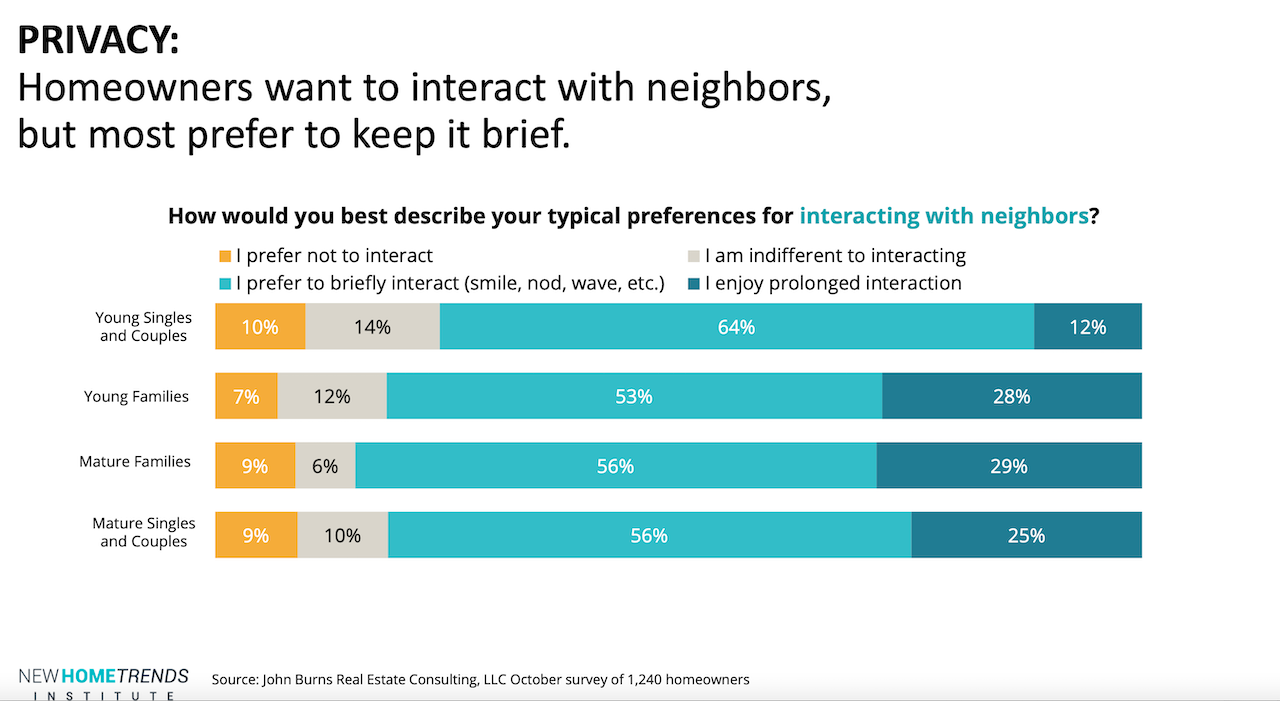Architecture
Delicate Balance: Privacy And Connectedness Both 'Must Have'
Make your homebuyer choose between either a full array of privacy solutions or an equally powerful feeling of connectedness at your peril. The data here shows a strong demand for a balance.

Homes designed for customers from scratch, it turns out, need to be both-and places, not either-or.
Take privacy and connectedness, for example. Don't they each rule the other out? Wouldn't trying to satisfy both needs and desires get too expensive?
Trade-offs for realistic cost and value that factor into lot size and density, square footage, finish specifications, and home technology solutions, notwithstanding, new homebuilders face rising levels of buyer discrimination on having both privacy and connectedness.
They unequivocally want both of these intangibles designed, engineered, and built into a new home. Both notions – privacy and connectedness – nest in our broader experience of well-being and peace-of-mind. We want to be secure, in our homes, that we can have it both ways.
How do we know this?
Data supports this both-and challenge for builders, and our own real-world experience of both the dynamics around the consequential meaning and value of privacy and the power of emotional connection to others and to the outdoors aligns with that data.
An upcoming research note on would be home buyers and renters from the Chubb Group notes in no uncertain terms the almost equally high prioritization of both privacy and close proximity to friends and family, i.e. connectedness:
Privacy and Land are Highly Valued – When searching for a new property, buyers are most drawn to land and privacy (30.6%), close proximity to friends and family (27%), a pool (26.9%), and indoor-outdoor living (26.9%).
Here, from the John Burns Real Estate Consulting team's analysis of 22 key trends for 2022, is a glimpse at how 1,240 homeowners answered survey questions about privacy this past October.

Privacy – by design, engineering, and construction – takes shape in features and functionality builders have drawn attention to in the pandemic era details that are evolving as more common floorplan and systems included items.
The JBREC team – notably Mikaela Arroyo, director of the New Home Trends Institute, Jenni Nichols, director of DesignLens, and Deana Vidal, manager, Trend Consulting – highlight:
- Open-concept layouts will correct from “wide open” to “strategically open.”
- The most important private space within the home is the bedroom. Owner’s bedrooms should be appropriately separated from common spaces, preferably off a separate hallway.
- Powder rooms should not be within sight or earshot.
- Privacy in the primary suite matters too.
Privacy, it's no surprise, is a big, and growing bigger, deal. This is reflected not just in what prospective homebuyers say about their attitude toward the fraught issues of privacy, but in how they behave – the buy-no buy, you-vs.-competitor behaviors that go beyond price and location considerations.
According to a Harvard Business Review analysis from Robert M. Waitman, director of Privacy Insights and Innovation at Cisco Systems and Thomas C. Redman, president of Data Quality Solutions, a 2019 survey from Cisco identified a gap between what companies understand to be drivers around privacy, and actual consumer behaviors.
The survey reveals an important new group of people — 32% of respondents — who said they care about privacy, are willing to act, and have done so by switching companies or providers over data or data-sharing policies. We call this group privacy actives and, to our best knowledge, this is the first time such a group has been identified.
The notion that significant numbers of privacy actives even exist should raise antennae at all companies. By understanding this unique group of individuals, whose feelings about privacy are multifaceted and complex, companies can shape their own data and customer privacy practices and better engage, retain, and work with these customers. This will take some effort.
The same level of effort will likely need to occur on the connectedness front, as more than three out of five homeowners relate that a deep emotional connection to their home – beyond its function to provide shelter and protection – is essential. Further, the increasing likelihood of flexibility and hybrid-schedule work lives has – as the JBREC trends study illuminates – left ...
...more room for communities based on shared values and interests. Work-from-home allows people to enjoy their communities more often than just evenings and weekends, raising the importance of communities that speak to unique personalities."
A home's fitness, come what may, in its ability to provide enduring protection and sanctuary – both physical and emotional and in the cyber sense – and, simultaneously, secure uninterrupted access not only to vital resources but to people and community connections, has taken on new meaning in a pandemic era that continues.
Choose to trade-off either privacy or connectedness – one in favor of the other – at your peril in customer-experience economic environment that demands a both-and balance.
Join the conversation
MORE IN Architecture
Integration Has Pivoted Into Homebuilding’s Survival Skill
Higharc’s "linked options" are pre-defined combinations of home features that account for all dependencies between design, materials, and pricing. Once defined, they automatically populate across all systems, reducing error and time-to-quote.
Florida Condo Project Sets Resilience Benchmark Early
Contributing writer Richard Lawson explores the challenges – and an urgent lane of future-proof opportunity for residential developers – in an exclusive interview with John Farina, president of U.S. Development.
Wellness Is the New 'Why' In Neighborhood Development
Health and well-being are no longer add-ons—they’re the foundation of value, purpose, and performance in new communities. From brain-friendly design to AI-native living, five big trends are redefining what home means now.
